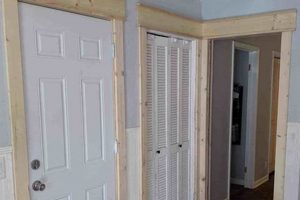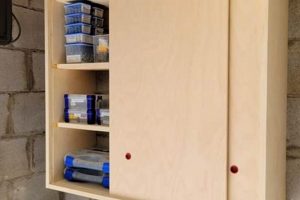A hinged, folding entry system, often constructed from wood and evoking a rustic aesthetic, allows users to create a space-saving doorway. This type of entrance combines the space-saving functionality of folding doors with the visual appeal of traditional barn doors. Examples of usage include closets, pantries, or room dividers where maximizing usable square footage is a priority.
The construction of such a door provides a cost-effective and customizable alternative to professionally installed systems. The design aesthetic offers a blend of modern efficiency and traditional charm, enhancing interior design. Historically, barn doors served a utilitarian purpose in agricultural settings, while bifold doors developed as a practical solution for space constraints within residential and commercial buildings.
The subsequent sections will detail material selection, step-by-step construction methods, hardware considerations, and finishing techniques required for successful fabrication and installation. Furthermore, considerations for safety and accessibility will be addressed.
Tips for Constructing a Folding Rustic-Style Entryway
The following advice is intended to guide the successful creation of a space-saving, aesthetically pleasing doorway system. Careful planning and execution are crucial for optimal results.
Tip 1: Material Selection. Prioritize kiln-dried wood to minimize warping or cracking post-construction. Pine is a cost-effective choice, while hardwoods offer enhanced durability and aesthetic appeal. Consider reclaimed lumber for a rustic appearance.
Tip 2: Accurate Measurements. Precise measurements of the door opening are essential before commencing construction. Account for the track system and any necessary clearances to ensure smooth operation.
Tip 3: Hardware Compatibility. Select a bifold door hardware kit specifically designed for the weight and dimensions of the intended door panels. Incompatible hardware can lead to operational issues and premature wear.
Tip 4: Sturdy Frame Construction. A robust frame is critical for the longevity of the structure. Employ mortise and tenon joints or reinforced screw connections to ensure structural integrity.
Tip 5: Precise Hinge Placement. Accurate alignment of hinges is vital for smooth and even folding action. Utilize a hinge jig to ensure consistent placement across all panels.
Tip 6: Track System Installation. Securely mount the track system to a structurally sound header. Use appropriate fasteners and ensure the track is perfectly level to prevent binding.
Tip 7: Finishing Techniques. Apply a durable finish to protect the wood from moisture and wear. Consider stains, paints, or clear coats depending on the desired aesthetic.
Tip 8: Safety Considerations. Install safety latches or guides to prevent the door from unexpectedly swinging open or closed. Ensure adequate clearance to avoid pinch points.
Adhering to these guidelines will contribute to the construction of a functional and visually appealing hinged, folding door system, maximizing space and enhancing the interior design.
The next section will explore common challenges encountered during the construction process and offer troubleshooting strategies.
1. Space optimization
Space optimization represents a primary driver for choosing a hinged, folding door system. Traditional swing doors necessitate clearance equal to their width, often impeding furniture placement or hindering movement in confined areas. The folding design mitigates this issue by collapsing the door panels to one or both sides of the opening, thereby reclaiming valuable floor space. This becomes particularly relevant in smaller homes, apartments, or areas like closets and pantries, where every square foot contributes significantly to overall functionality.
The effectiveness of space optimization is directly proportional to the accuracy of the door’s design and installation. Improperly sized or installed doors can negate the intended space-saving benefits. For example, if the folded panels protrude excessively into the room due to incorrect measurement, the realized space savings are diminished. Similarly, a poorly operating system that requires excessive force to open or close impedes efficient utilization of the area. Examples include instances where a folding door allows for a wider hallway by eliminating the need for a swinging door’s clearance, or where it permits the addition of shelving in a small closet otherwise obstructed by a traditional door.
In summary, the relationship between space optimization and this door design is characterized by a direct cause-and-effect. The folding mechanism creates space efficiency. While achieving optimal optimization depends heavily on design accuracy, and precise installation. Recognizing the practical significance of this understanding allows homeowners and contractors to maximize usable area, particularly within space-constrained environments, thereby increasing property value and improving overall living conditions.
2. Material durability
Material durability directly influences the lifespan and functionality of a hinged, folding rustic-style entry. The choice of materials determines the door’s resistance to environmental factors, wear and tear, and structural integrity over time. The inherent properties of the selected wood, hardware, and finishes correlate directly with the system’s long-term performance and aesthetic appeal. This consideration is more important in applications that are heavily used, such as for frequently accessed pantries or high traffic areas.
Substandard materials yield negative consequences, including warping, cracking, joint failure, and finish degradation. Softwoods, if not properly sealed and protected, are susceptible to moisture damage and insect infestation. Inferior hardware components may exhibit premature wear, leading to operational difficulties and eventual failure. Conversely, using durable hardwoods such as oak or maple, coupled with high-quality hinges and a protective finish, can significantly extend the lifespan. For example, a door constructed with pressure-treated lumber and marine-grade hardware offers superior resistance to moisture and corrosion in humid environments, ensuring long-term performance.
In conclusion, material durability is a critical determinant of the overall value and utility of a space-saving, aesthetically pleasing doorway system. Investing in durable materials translates to reduced maintenance, enhanced longevity, and improved performance, resulting in a more cost-effective and satisfying solution in the long run. The selection of robust materials is essential in ensuring the product performs for years, making it important to consider how and where a door like this is going to be implemented.
3. Hardware selection
Hardware selection forms a critical juncture in the successful implementation of a hinged, folding rustic-style entry system. The operational efficiency, longevity, and aesthetic integration of the door are directly contingent upon the appropriate choice of hardware components.
- Track System Specifications
The track system dictates the smooth lateral movement of the door panels. The weight capacity of the track must exceed the combined weight of the door panels to prevent sagging or binding. Material composition, such as steel or aluminum, influences durability and corrosion resistance. For example, a heavy, solid wood door requires a robust steel track system, while a lighter door may function adequately with an aluminum track. Improper track selection compromises operational smoothness and potentially shortens the lifespan of the entire system.
- Hinge Mechanisms and Placement
Hinges facilitate the folding action of the door panels. Hinge type (e.g., butt hinges, piano hinges) affects the smoothness of the folding action and the overall structural integrity of the door. Precise hinge placement is crucial for even distribution of weight and alignment of the panels. Incorrectly placed or inadequate hinges can cause the door to bind, warp, or fail prematurely. The hinge quantity, size, and material must be appropriate for the dimensions and weight of the door panels.
- Roller Assemblies and Guides
Roller assemblies ensure smooth and quiet movement along the track. Bearing type, wheel material (e.g., nylon, steel), and wheel diameter affect the smoothness of the door’s operation and its resistance to wear. Guides prevent lateral movement and maintain proper alignment. The selection of appropriate roller assemblies and guides contributes to the door’s stability and ease of use. Inadequate roller assemblies may result in a noisy and uneven sliding motion, detracting from the overall user experience.
- Latch and Security Hardware
Latch and security hardware provides closure and security for the door. Latch mechanisms vary in design and security level. For example, a simple magnetic latch may suffice for a closet door, while a keyed lock provides enhanced security for a room divider. The choice of latch and security hardware depends on the intended application of the door and the desired level of security. Insufficient or poorly chosen latch hardware can compromise the privacy and security of the space the door encloses.
The interconnectedness of these hardware components emphasizes the holistic approach required for successful implementation. Selecting appropriate hardware is important for ensuring smooth operation, enhancing longevity, and maintaining the overall functionality of a folding rustic-style door system. Properly chosen and installed hardware contribute to a final product exhibiting visual appeal and practical utility.
4. Smooth operation
Smooth operation constitutes a key performance indicator for a hinged, folding rustic-style entry system. The user experience is directly linked to the ease and fluidity with which the door opens, closes, and folds. A system characterized by binding, sticking, or excessive noise detracts significantly from its usability and perceived value.
- Track Alignment and Leveling
Precise alignment and leveling of the track system are fundamental for ensuring smooth lateral movement of the door panels. Misalignment creates friction and resistance, impeding the door’s ability to glide effortlessly. For instance, even a slight deviation from horizontal can cause the rollers to bind, requiring increased force to operate the door. Real-world examples demonstrate that meticulous attention to track installation is paramount for achieving optimal operational efficiency.
- Roller Quality and Lubrication
The quality of the roller assemblies and their lubrication directly impact the smoothness of the door’s movement along the track. High-quality rollers, constructed from durable materials with precision bearings, minimize friction and noise. Regular lubrication reduces wear and tear, ensuring consistent performance over time. An example of this relationship is a nylon roller, with ball bearings, operating smoothly as a result of lubrication at recommended intervals.
- Hinge Placement and Adjustment
Accurate hinge placement and subsequent adjustment are vital for facilitating the seamless folding action of the door panels. Misaligned hinges cause the panels to bind against each other, impeding smooth operation. Precise adjustment ensures that the panels fold evenly and without excessive force. An instance might involve adjusting hinges slightly to account for minor imperfections in the wood, therefore ensuring a seamless fold.
- Clearance and Obstruction Management
Maintaining adequate clearance between the door panels, the track, and surrounding surfaces is essential for preventing obstructions and ensuring smooth operation. Debris accumulation or dimensional inconsistencies can impede the door’s movement. Periodic inspection and cleaning are necessary to remove any obstructions that may hinder smooth operation. In situations, where there may be carpeting or uneven floor surfaces, these must be accounted for to maintain sufficient clearances. Failing to account for this might hinder the operation of the door.
The interplay of these facets underscores the multifaceted nature of achieving smooth operation in a diy bifold barn door system. Attention to detail during installation, selection of quality hardware, and proactive maintenance are crucial for maximizing the user experience. By addressing these elements comprehensively, the system exhibits both functionality and aesthetic appeal, realizing the potential of the design.
5. Aesthetic cohesion
Aesthetic cohesion, representing the harmonious integration of visual elements, is paramount when constructing a folding rustic-style entry. The door should complement the existing interior design, contributing to a unified and visually pleasing environment. Failure to achieve aesthetic cohesion results in a discordant element, detracting from the overall ambiance of the space.
- Style Compatibility
The door’s style must align with the prevailing aesthetic of the room or adjacent spaces. A rustic barn door design may be appropriate for a farmhouse-style interior. However, it might clash with a modern or minimalist setting. Consideration of architectural details, color palettes, and furniture styles is essential for ensuring stylistic harmony. An example would be matching the door’s hardware finish to other metal fixtures in the space, creating a unified look.
- Material Consistency
The materials used in the door’s construction should complement existing materials within the space. Matching wood tones, hardware finishes, and textural elements contributes to a cohesive aesthetic. For instance, a reclaimed wood door complements interiors featuring exposed brick or natural stone elements. Conversely, mismatching materials creates visual discord, disrupting the overall aesthetic balance.
- Color Palette Integration
The door’s color should harmonize with the room’s existing color palette. Selecting a color that complements or contrasts effectively with the walls, trim, and furnishings is critical. A door painted a shade found elsewhere in the room, like picking up an accent color, helps create a pulled-together look. Conversely, introducing a color that clashes with the existing palette disrupts the visual flow and diminishes aesthetic appeal.
- Hardware and Detailing
Hardware and detailing elements contribute significantly to the door’s aesthetic impact. Selecting hardware finishes that complement other metal elements within the space creates a cohesive look. Decorative details, such as trim, panels, or embellishments, should align with the overall design aesthetic. For example, using wrought iron hardware on a door with rustic wood paneling reinforces the barn door aesthetic. Inconsistent hardware or detailing disrupts the visual harmony and diminishes the door’s overall aesthetic appeal.
These facets of aesthetic cohesion culminate in a harmonious integration of the folding rustic-style entry within its surrounding environment. Careful consideration of style, material, color, hardware, and detailing ensures that the door enhances rather than detracts from the overall aesthetic of the space. Success in this area contributes to the overall perception of value and satisfaction with the “diy bifold barn door” project.
6. Installation accuracy
Installation accuracy is a pivotal determinant in the successful implementation of a diy bifold barn door system. Deviations from precise measurements and proper installation techniques directly impact the system’s functionality, longevity, and aesthetic appeal. The cause-and-effect relationship between installation accuracy and the overall performance of the door is significant. For example, an improperly leveled track system causes the door to bind or fail to slide smoothly, negating the space-saving benefits and creating user frustration. A poorly installed door, even with high-quality materials, ultimately underperforms and detracts from the intended rustic aesthetic. Proper shimming, precise alignment, and secure fastening are examples of installation accuracy’s practical application. Installation accuracy is essential to achieving the designed result.
Real-world applications highlight the importance of meticulous installation. Consider the scenario where a homeowner, aiming to maximize closet space, installs the track system with a slight incline. The result is a door that either slides open on its own or requires excessive force to close, defeating the purpose of the space-saving design. Similarly, inadequate support for the track system leads to sagging, compromising the door’s ability to operate smoothly and potentially causing structural damage. Professional installers often employ laser levels and precision measuring tools to ensure accuracy, minimizing the risk of such issues. Another example is a failure to accurately account for floor slope or unevenness. This directly affects the door’s ability to properly sit within the opening, requiring shimming of the track to correct the geometry.
In summary, installation accuracy is a non-negotiable component of a successful “diy bifold barn door” project. Challenges in achieving accuracy often stem from insufficient planning, inadequate tools, or a lack of experience. By prioritizing precision and adhering to proper installation techniques, homeowners can maximize the functionality, longevity, and aesthetic appeal. Recognizing and addressing the practical significance of installation accuracy contributes to a functional and visually pleasing final product, aligning with the goals of a DIY installation project and demonstrating attention to detail.
Frequently Asked Questions Regarding DIY Bifold Barn Doors
The following addresses common inquiries concerning the construction and installation of folding rustic-style entry systems. These questions aim to clarify key aspects of the project and provide informative guidance.
Question 1: What is the minimum opening width required for a functional folding rustic-style entry?
The minimum opening width depends on the number of panels and desired passage clearance. A two-panel configuration necessitates an opening width at least twice the width of a single panel plus any allowances for hardware or overlaps. Precise measurements are crucial for ensuring adequate accessibility. Consult hardware specifications for recommended clearances.
Question 2: What type of wood is best suited for constructing this system, considering both cost and durability?
Pine represents a cost-effective option for the panels. However, hardwoods, such as oak or maple, offer enhanced durability and resistance to wear. Kiln-dried lumber is recommended to minimize warping and cracking. The selection should balance budgetary constraints with the long-term performance requirements.
Question 3: What hardware is essential for achieving smooth and reliable operation?
A robust track system, high-quality hinges, and smooth-rolling roller assemblies are essential. The track system’s weight capacity must exceed the combined weight of the panels. Hinge placement should be precise to ensure even folding. Roller assemblies should feature durable bearings to minimize friction and noise.
Question 4: What safety precautions must be observed during construction and installation?
Eye protection, dust masks, and hearing protection are recommended during cutting and sanding operations. Secure panels during installation to prevent accidental falls. Ensure proper anchoring of the track system to prevent detachment. Consult safety guidelines for power tool operation. Attention to safety minimizes the risk of injury.
Question 5: How can the system’s longevity be maximized?
Regular cleaning, lubrication of moving parts, and prompt repair of any damage contribute to extended system life. Apply a protective finish to the wood to prevent moisture damage. Avoid exposing the system to excessive humidity or extreme temperatures. Proactive maintenance preserves functionality and aesthetic appeal.
Question 6: What are the common challenges encountered during installation, and how can they be addressed?
Common challenges include track misalignment, panel binding, and uneven folding. Addressing track misalignment requires precise leveling and shimming. Panel binding may result from improper hinge placement or warping, necessitating adjustment or panel replacement. Uneven folding can be corrected by adjusting hinge tension or repositioning panels. Accurate measurement and careful execution minimize potential challenges.
These FAQs highlight considerations and challenges associated with implementing such a door system. Careful planning, material selection, and adherence to safety guidelines contribute to a successful outcome.
The subsequent section will provide a detailed step-by-step guide to the construction process.
Concluding Remarks
The preceding sections have detailed aspects of constructing a diy bifold barn door. The content highlights the criticality of material selection, hardware compatibility, installation accuracy, and aesthetic cohesion. A comprehensive understanding and careful execution of each stage are essential for achieving the intended functional and aesthetic goals. These considerations collectively contribute to a successful installation.
Ultimately, the construction of such a system represents a balance between practical space optimization, aesthetic integration, and technical skill. Continued adherence to established best practices, combined with a commitment to meticulous craftsmanship, will yield long-term benefits. The successful implementation enhances the value and usability of the intended space.







